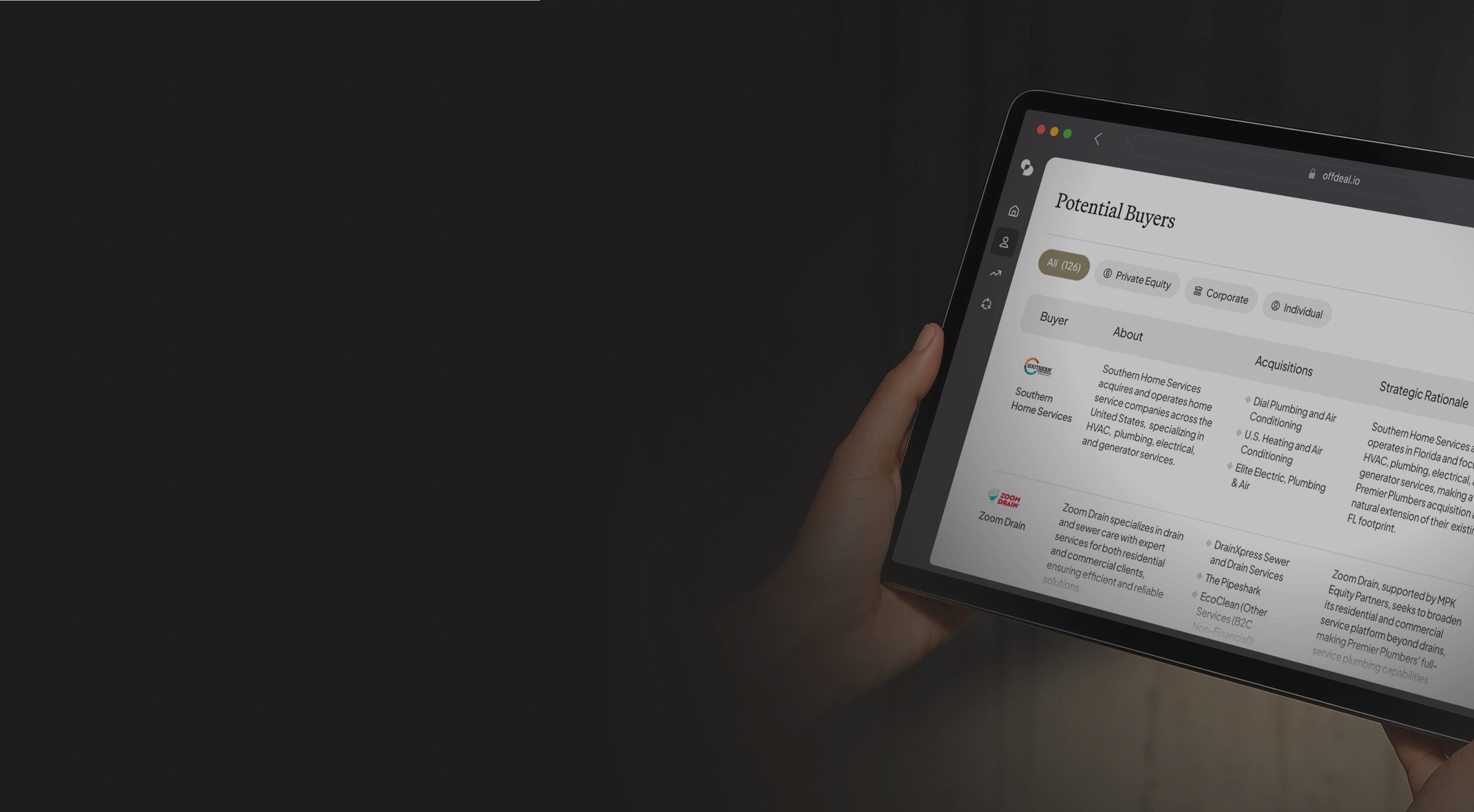Article
February 9, 2025
Avoiding Common Deal Breakers When Selling a Roofing Business
Selling your roofing business? Avoid these deal breakers & maximize Value—plus expert strategies to fix them.

Table of Contents
Selling your roofing business can represent the culmination of years of hard work, late nights, and careful planning. Yet countless small business owners find their dream sale slips through their fingers at the negotiating table, all due to hidden pitfalls and overlooked deal breakers. Whether you're preparing to retire, exploring other ventures, or passing the business down to new management, avoiding these common issues can mean the difference between closing a great deal or walking away empty-handed.
To sell your roofing business smoothly, it helps to know in advance what pitfalls buyers and brokers commonly flag. Understanding these potential deal breakers— and how to preemptively address them—can dramatically increase your chances for a successful sale while maximizing your company's market valuation.
In this guide, you'll learn:
The top deal breakers that turn potential buyers away
How poor record-keeping and financial statements can derail your deal
Why excessive owner dependency dramatically hurts your valuation
The impact of customer concentration risks and limited service diversification
Best practices for reducing liabilities like warranty claims and regulatory non-compliance
Practical tips for shaping up your roofing business before sale to avoid deal-robbing issues
Financial Red Flags
Your potential buyers or brokers will put your financial statements under a microscope. Messy, disorganized, or overly optimistic financial records rank among the fastest ways to torpedo a sale. Let's look at the most common financial deal breakers:
Poorly Organized Financial Statements
Nothing alarms prospective buyers faster than unorganized or unclear financial statements. Issues include:
Personal and business expenses mingled together
Unexplained revenue fluctuations from year to year
Missing documentation and invoices
Chronically delayed accounts receivable
Inconsistent Profit Margins or Declining Revenue
Buyers seek steady, predictable revenue—or at least clear explanations for fluctuations. Unexplained dips in annual revenue or shrinking margins raise red flags, causing buyers to either lower their offer or walk away entirely.
Excessive Debt or Liabilities
Large loans, unpaid taxes, or ongoing litigation claims drastically lower your business's perceived worth. Buyers prefer companies with manageable liabilities and a clear path to profitability without heavy outstanding burdens.
Improving Your Financials: Actionable Steps
Maintain clear, organized financial records separated from personal accounts.
Normalize "Owner's Compensation" clearly within the balance sheets to accurately reflect true profitability.
Show realistic, steady profit margins and address revenue fluctuations transparently.
Settle outstanding debts ahead of time or negotiate favorable payment schedules.
Owner Dependency Issues
When your roofing company depends too heavily on your personal involvement, buyers worry about sustained profitability after your departure.
Lack of Standard Operating Procedures (SOPs)
Without clear SOPs, buyers fear operational chaos once the current owner exits. Companies without documented processes, job safety guidelines, customer service routines, or invoicing practices seem riskier to potential buyers.
Personal Relationships Driving Business Revenue
Excessive reliance on personal relationships between the owner and major customers generates uncertainty. Buyers doubt their ability to successfully transition and maintain relationships once ownership changes.
Reducing Owner Dependency: Practical Solutions
Document detailed SOPs covering sales, project management, HR procedures, and billing practices.
Delegate client management, project oversight, and sales duties among trained employees.
Clearly demonstrate that key relationships align with your company's brand and quality service—not just your personal influence.
Customer Concentration Risks
Excessive revenue dependence on just a handful of customers presents a massive hurdle for potential buyers.
Revenue Concentration in a Few Clients
If only a handful of clients contribute more than 30–40% of your total revenue, this poses significant risk. Losing even one major client could dramatically affect business profitability post-sale.
Limited Service Diversification
Buyers prefer roofing businesses with stable operations and a mix of services, including ongoing repair, inspection, and maintenance revenue—not purely one-time installation jobs dependent on new construction activity.
Diversifying Customer Base & Services: How to Improve This Quickly
Actively diversify your client base through targeted marketing to new residential or commercial segments.
Add recurring revenue streams, such as inspection services, regular roof maintenance, or additional services like gutter cleaning or weather-proof coatings.
Establish contracts or service agreements with property managers or commercial facilities for ongoing maintenance.
Liability Exposure and Regulatory Compliance Issues
Historical or potential claims against your roofing business signal significant risk, causing buyers to pause or walk away from negotiation.
Excessive Warranty Claims or Installation Issues
Potential buyers avoid inheriting warranty headaches or reputational baggage from faulty installations. Numerous open claims or poor reputation online because of unresolved issues severely damaged your valuation.
Regulatory Non-compliance
Buyers fear unforeseen regulatory penalties. Common rental compliance issues include:
Licensing and permit non-compliance
Occupational safety (OSHA violations)
Missing or outdated employee safety training records
Improper labor practices or contract classifications (e.g., subcontractors incorrectly labeled as employees)
Reducing Liability Exposure: Actionable Steps
Maintain meticulous warranty records, quickly resolve outstanding issues, and prevent future claims through quality control systems.
Conduct an internal compliance audit before sale, resolving license violations or safety gaps promptly.
Use thorough employee training procedures and regularly updated safety guidelines.
Real-World Examples: Two Roofing Companies Compared
Let's view the scenario clearly through a comparison. Both roofing businesses below generate the same Seller's Discretionary Earnings (SDE), but risk profiles differ dramatically:
| Factors | Roofing Co. A | Roofing Co. B |
|---|---|---|
| Annual Revenue | $5M | $5M |
| SDE | $800K | $800K |
| Financial Statements | Clear, detailed, and independently audited | Disorganized, unclear expenses, and personal expenses mixed in |
| Customer Base | Diversified customer base across commercial and residential sectors | Three customers represent 65% of revenue |
| Recurring Revenue | Significant recurring roof maintenance contracts | Primarily one-off projects dependent on new developments |
| Owner Dependency | SOPs deployed, employee-managed operations | Owner handles key relationships, sales, and daily operations |
| Liabilities & Compliance | Strong compliance and licenses; minimal claims history | Multiple warranty claims, an open litigation issue, and possible safety violations |
| Valuation Multiple Estimate | ~5–6x SDE | ~2–3x SDE (or a failed deal) |
Why Does Roofing Co. A Command a Higher Valuation?
Diversified revenue minimizes customer concentration risks.
Strong recurring revenue gives buyers confidence in future earnings.
Detailed financial records convey stability and trustworthiness.
Documented processes reduce owner dependency, ensuring smooth operations transfer.
Lower liabilities and excellent regulatory compliance significantly reduce risk.
Improving Valuation Before Your Sale
Position your roofing business attractively by proactively addressing these deal breakers:
Clean & Organized Financial Records: clearly separating personal from business finances to instill buyer confidence.
Reduce Owner Dependence: documenting procedures, training your staff, and showcasing a company independent of your daily input.
Diversify Revenues & Customer Base: to mitigate risks and maintain stable cash flows for the next owner.
Resolve All Potential Liabilities & Compliance Issues: to remove buyer worries over inheriting costly issues or regulatory problems.
Next Steps to Successfully Sell My Roofing Business
Selling your roofing business is possible—and extremely profitable—when you're proactive rather than reactive. Addressing common deal breakers in advance helps you confidently enter negotiations, knowing your business command maximum value.
As you prepare to sell a roofing business, remember:
Buyers prefer clear financial records and minimal liabilities.
Service diversification and recurring revenues dramatically boost valuation.
Owner-independent operations accelerate sales and justify premium pricing.
Proactive risk management and compliance reduce deal-breaking fears.
If you're considering selling your roofing business and want professional advice tailored to your unique situation, schedule a confidential consultation to:
Discuss current market conditions for roofing firms.
Understand valuation drivers specific to your business model and market.
Explore practical steps you can take now to maximize your selling price and eliminate potential deal breakers.
By understanding and addressing these critical issues, you ensure your transition occurs smoothly—yielding the best possible outcome as you pass your hard-earned roofing business to its next owner.

Preview Buyers for Free
Try our buyer match tool to receive a personalized list of active buyers in your industry

